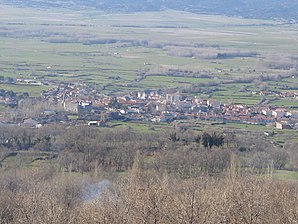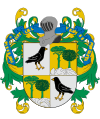Piedrahíta (Ávila)
| Piedrahíta municipality | ||
|---|---|---|
 Piedrahita - town view
|
||
| coat of arms | Map of Spain | |

|
|
|
| Basic data | ||
| Autonomous Community : | Castile and Leon | |
| Province : | Ávila | |
| Comarca : | El Barco de Ávila-Piedrahíta | |
| Coordinates | 40 ° 28 ′ N , 5 ° 20 ′ W | |
| Height : | 1065 msnm | |
| Area : | 28.67 km² | |
| Residents : | 1,822 (Jan 1, 2019) | |
| Population density : | 63.55 inhabitants / km² | |
| Postal code : | 05500 | |
| Municipality number ( INE ): | 05186 | |
| administration | ||
| Website : | Piedrahita | |
Piedrahíta is a place and a municipality ( municipio ) in northern Spain with 1,822 inhabitants (as of January 1, 2019) in the province of Avila in the autonomous community of Castile and León . The old town center was classified as a cultural asset ( Bien de Interés Cultural ) in the Conjunto histórico-artístico category.
location
Piedrahíta is located in a fertile valley on the only 4 km long Río Pozas , a tributary of the Río Corneja in the Sierra de Gredos at an altitude of about 1065 m above sea level. d. M. The provincial capital Ávila is about 65 km (driving distance) to the northeast. The climate in winter is cool, in summer it is quite warm despite the altitude; the low amounts of precipitation (approx. 475 mm / year) fall - with the exception of the almost rainless summer months - distributed over the whole year.
Population development
| year | 1857 | 1900 | 1950 | 2000 | 2017 |
| Residents | 1,951 | 2,936 | 3.136 | 2,169 | 1,823 |
The significant population decline since the 1950s is mainly due to the mechanization of agriculture and the associated loss of jobs.
economy
Agriculture, especially cattle breeding, traditionally plays the largest role in the economic life of the mountain community, which in earlier times was also a regional center for handicrafts and trade for the hamlets and individual farms in the area. Income from tourism in the form of renting out holiday homes (casas rurales) has increased over the last few decades.
history
The first traces of settlement come from the Celtic period ( Vettones ); Roman and Visigoth origins are assumed for two hermitages outside the village and near the river ( Ermita de San Miguel de Corneja and Ermita de Santa María de la Vega ). During the Islamic rule that began in the 8th century over large parts of the Iberian Peninsula , the area was depopulated; Around the year 918 it was allegedly recaptured by the Castilian Count Fernán González , but a few years later it was again taken by the Moors . Only in the 11th and 12th centuries it was finally recaptured ( reconquista ) , repopulated ( repoblación ) and surrounded by a wall. The first written mention of the place name Piedrahíta (Latin: petra ficta = "hewn stone" or "keystone") comes from the year 1189.
The manor Señorío de Valdecorneja was possibly established as early as the 11th century , and in the 15th century came into the possession of the House of Álvarez de Toledo , from which the Dukes of Alba emerged in 1465 , who mainly resided in Alba de Tormes and Madrid . In the years 1755–1766 they also built a summer residence in the French style outside of Piedrahíta ( Palacio de los duques de Alba ). At the end of the 18th century, the palace experienced a renewed heyday under the Duchess of Alba , who was also known to the painter Francisco de Goya and was portrayed by him several times.
Attractions
- The Plaza de Espana , the main square, forms the actual center of the old town; it is surrounded by arcaded houses that protect visitors from both rain and excessive sunlight. A fountain from 1727 with an octagonal border stands in the middle of the square.
- From the originally three-aisled church of Santa María la Mayor , the squat bell tower (campanar) has been preserved. In the 16th century the church was rebuilt into a collegiate church - a cloister (claustro) was built in the west , a five-arched porch ( portico ) was added on the south side , which was probably a later successor to the Romanesque south porches in the provinces of Burgos , Soria and Segovia must be understood. The new south portal shows a Madonna and Child, which is framed by two keel arches with pinnacles on top of them; changes on the north side resulted in several chapels. The interior of the church, which has been transformed into a museum for sacred art, presents several altarpieces , numerous figures and works of goldsmithing .
- The ruins of the Dominican monastery , founded by the second Señor de Valdecorneja , date back to the second half of the 14th century, and which was maintained by the order until the church and monastery property was disastrous in 1834/5.
- The Carmelite convent was founded in 1460 by María de Vargas y Acebedo , a noble lady. The rather inconspicuous portal shows an Alfiz frame and a stone coat of arms of the Dukes of Alba. In the chapel there is the painting El Granadino by the hand of the painter Alonso Cano .
- Surroundings
- The two-storey ducal palace ( Palacio de los duques de Alba ) is a few kilometers outside the town. The French style of its architect Jacques Marquet is evident in the multi-wing system and the steep mansard roof .
- The single-aisled hermit church Ermita de Santa María de la Vega is also outside the village. It is the goal of an annual pilgrimage (romeral) on the first Monday after Pentecost.
- The bullring (plaza de toros) with its architectural echoes of neo-Moorish and neo-baroque styles dates from 1951.
Personalities
- Beata de Piedrahita (1485–1525), unknown by name, was a Carmelite and a mystic and predecessor of St. Teresa of Ávila .
- Fernando Álvarez de Toledo, 3rd Duke of Alba ( El Gran Duque ) was born in Piedrahíta in 1507.
- Maria del Pilar Teresa Cayetana de Silva y Álvarez de Toledo , better known under the name of Duchess of Alba (1762–1802) was the muse, possibly also Goya's lover, whom she repeatedly had as a guest in the castle.
Web links
Individual evidence
- ↑ Cifras oficiales de población resultantes de la revisión del Padrón municipal a 1 de enero . Population statistics from the Instituto Nacional de Estadística (population update).
- ↑ Piedrahita - map with altitude information
- ↑ Piedrahita - climate tables
- ↑ Piedrahita - population development
- ↑ Piedrahita story
- ^ Piedrahita - Collegiate Church
- ↑ Piedrahita - Sights
- ↑ Piedrahita - Sights



